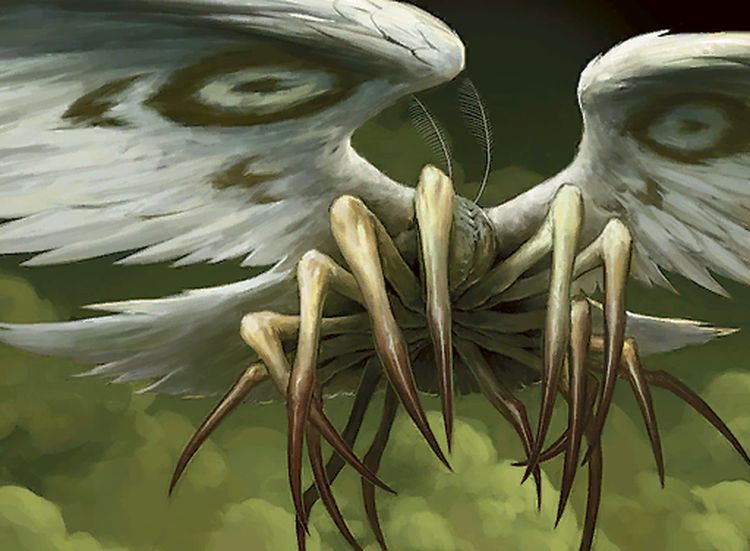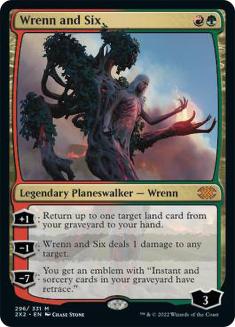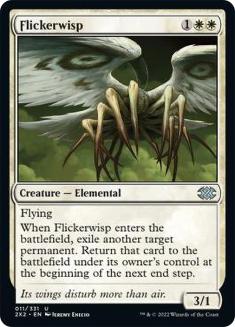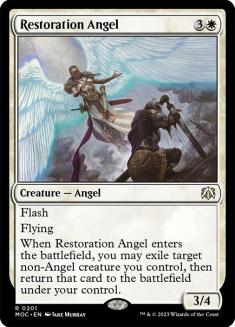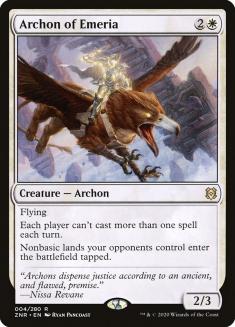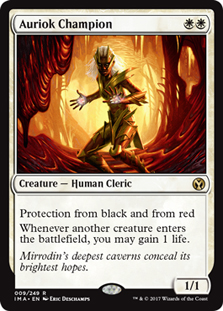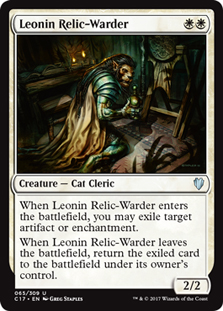I don’t know exactly what I expected from Monday’s Banned and Restricted announcement. Uro, Titan of Nature’s Wrath should’ve been gone a long time ago, and certainly something needed to be done about all the cascade nonsense that completely overtook Modern and Legacy for the last couple of weeks. But to ban fifteen cards across nearly every non-Standard Constructed format as well as issue a rules change on cascade is unprecedented.
Pioneer, Historic, Modern, and Legacy are going to be wide open for the time being, as players revisit cherished archetypes and re-tune the decks that survived at least mostly intact. However, I have found that in immediately post-ban metagames, many people are quick to default to the best-performing decks which were untouched by such a ban. For Modern, that means a lot of Colossus Hammers and Monastery Swiftspears.
Those decks are powerful and would make fine choices, but I’d rather go a little deeper and try to attack those elements of the metagame while retaining a powerful, proactive strategy which can perform well in an open field. After considering many options, the deck I’m interested in right now for Modern is Death & Taxes.
Death & Taxes fell off from its peak last fall, but has still maintained a significant presence in the metagame over the past few months. It’s a proven strategy, and I think there are several metagame forces that should allow it to thrive in the coming weeks, if not longer:
White Removal Lines Up Well Against Death’s Shadow
If I need to answer Death’s Shadow and friends to succeed in Modern, you can’t do much better than Path to Exile and Skyclave Apparition. Early Paths can sometimes be awkward with your mana denial plan if you don’t have Leonin Arbiter, which is part of the reason Apparition was such an important addition to the deck. Now you have a more reliable answer to their first threat, and even if they have the Lightning Bolt or Fatal Push, the token they’re left with after the dust settles is not a threat.
In exchange for this awkwardness, you get a full line-up of exile-based removal, which is so important against Lurrus of the Dream-Den. Lurrus is the late-game plan for so many Death’s Shadow variants, and without it your combination of flying creatures and Equipment will rule the late-game. Lurrus also pops up in a lot of creature combo decks, including the most popular of the group in Mono-White Equipment.
The removal of Uro may lead players to shy away from exile-based removal as less important than before, but there’s still plenty of Modern decks that actively look to utilize their graveyard, and Death & Taxes is primed to prey on them.
Fewer Wrenn and Sixes
Wrenn and Six is the bane of creature decks throughout Modern, but especially Death & Taxes. Between Thalia, Guardian of Thraben and Flickerwisp, there are enough targets for the -1 ability, and the +1, which normally is just insurance against early stumbles, actively undoes most of the disruptive elements that Death & Taxes has. Even with Skyclave Apparition as an answer, its significant presence in the metagame is problematic.
But with the Uro ban, I expect Wrenn and Six’s stock to drop. It has largely seen play in blue decks that, because of Uro, have green as their secondary color. This made Wrenn and Six a natural addition, since splashing red for removal also made sense. But now there’s much less incentive to be green. Ice-Fang Coatl is a good card, but not enough by itself. There’s still Omnath, Locus of Creation, but Uro was a big part of that card’s success.
We may eventually get to a point where Simic-based decks thrive again, but at the very least tuning a new list is going to take several weeks, and in the meantime I expect many other blue control variants to be tried and tested. And that means a lot fewer copies of Wrenn and Six.
And if you’re thinking that Jund Midrange will pick up again and keep the planeswalker around in high numbers, stop it. It’s 2021, not 2011. The world has evolved past the need for Jund.
The Return of Tron
The last factor I see favoring Death & Taxes is a resurgence in Urzatron decks. Primeval Titan has been completely dominant when it comes to big-mana decks in Modern, but losing Field of the Dead is a huge blow, since that was by far their best late-game plan.
Coupled with that, the Uro ban means that there’s more room for various midrange decks to thrive, and it’s those decks that Mono-Green and Eldrazi Tron thrive against. As much as I doubt Jund, I expect it to be around a little more, alongside various Stoneblade strategies and whatever Yorion nonsense Corey Baumeister comes up with. And without Uro, these midrange and control decks aren’t nearly as good at turning the corner and applying pressure to Tron players.
For a while now, an early Uro backed by a Force of Negation was a great plan against Tron. And even if you don’t have the Force, Uro would ramp you enough that you could have mana up on the turn you escape Uro. Uro then supplied a cascading stream of cards that would likely net enough answers to shut down the Tron player for the rest of the game. Other threats like Stoneforge Mystic and Shark Typhoon can approximate the pressure, and planeswalkers like Jace, the Mind Sculptor or Teferi, Hero of Dominaria can approximate the card advantage, but no card is giving you both.
The pressure and mana denial of Death & Taxes gives it an excellent matchup against Tron variants, so any increased presence of those decks is going to benefit Leonin Arbiter and friends. And I expect both Mono-Green Tron and Eldrazi Tron to return in a big way in the coming weeks.
My Current List
Creatures (26)
- 4 Flickerwisp
- 4 Stoneforge Mystic
- 4 Leonin Arbiter
- 4 Thalia, Guardian of Thraben
- 2 Restoration Angel
- 4 Giver of Runes
- 4 Skyclave Apparition
Lands (23)
Spells (11)

The list itself is relatively straightforward. Most of the card choices are locked in since they’re necessary pieces of the deck, and I’m wary of over-metagaming the list at least in the first week since there will be a lot of players trying out new strategies.
Recent lists of Death & Taxes have trimmed Flickerwisp or cut it entirely. In a world with a lot of Wrenn and Sixes as well as Lava Dart in the Prowess decks, I can understand wanting to move away from a one-toughness creature, especially one that costs three mana. But in a more open metagame, Flickerwisp is absolutely one of the best cards in the deck. It’s incredibly versatile, and in combination with Aether Vial, it opens many options that you only learn to appreciate when you play with the card enough.
There are basic maneuvers like blinking your Stoneforge Mystic to get another Equipment or targeting an opposing token to remove it permanently. But with Aether Vial you can use Flickerwisp to protect your creatures from spot removal, exile a key attacker, or even target a land on your opponent’s upkeep to keep them off mana for a sweeper. None of these effects would make the card powerful enough to play on its own, but when you combine them all together you get something impressive. Until the post-ban metagame proves to be overly hostile to one-toughness creatures, I’m playing four Flickerwisps.
I rounded out my list with two copies of Restoration Angel, where other lists have Archon of Emeria. Both are solid creatures, but I’ve always prioritized pressuring my opponent with Death & Taxes decks, since your opponent will always draw enough lands to render your mana denial plan irrelevant if given enough time. Restoration Angel’s sizing and ability to protect other threats thus earn it the slot.
In the sideboard, I view the full set of Auriok Champions as non-negotiable for now, since I expect Rakdos Death’s Shadow to be the most popular archetype this weekend. I also added a third piece of graveyard hate since I expect Dredge to come back in a big way. Uro combined with the Cryptic Command + Mystic Sanctuary loops was powerful enough that blue decks were beating Dredge without hate, and there’s going to be some lag between the time they realize they need to play more and when they actually do. I intend to come prepared from the outset. I chose Grafdigger’s Cage over a third Rest in Peace because the one-mana difference is important when you’re on the draw, and it has applications against Collected Company decks.
The Leonin Relic-Warder is a nod to opposing Aether Vial, Stoneforge Mystic, and Colossus Hammer decks, while the Gideon, Ally of Zendikar should once again be a haymaker against control decks now that they don’t have a 6/6 on their side of the battlefield. The sideboard will change a lot as a new metagame takes shape, but I like this as a starting point since it attacks the most popular decks while also preparing for a wider range of strategies.
The Yorion Question
Recently, different variants of Death & Taxes utilizing Yorion, Sky Nomad as a companion have emerged. These lists typically play a second color, either blue or green, and use Yorion to help in games that come down to attrition. Between Flickerwisp, Restoration Angel, and Charming Prince, there are plenty of ways to create perpetual loops with Yorion that quickly end the game with overwhelming card advantage.
However, I don’t think Yorion helps the deck overall, since at the same time you dilute the mana denial plan. Leonin Arbiter polarizes your draws. With it, your Ghost Quarters and Path to Exiles are incredibly good, and without it they’re just okay. Having such a card in your deck raises the opportunity cost of playing Yorion as a companion, since adding twenty cards to your deck means you’re less likely to find Leonin Arbiter in the early-game.
When I look at Death & Taxes lists with Yorion, I see half a Soulherder deck and half a Death & Taxes deck mashed together, and I don’t think the two decks help mitigate each other’s weaknesses. With the mana denial cards in the deck, you still won’t have the card advantage to compete with dedicated attrition decks with powerful planeswalkers and the like. And with the extra value elements in the deck, your mana denial plan won’t come together often enough.
This is the most disruptive ban announcement in the history of Magic. It’ll take some time for everything to sort itself out. But this coming period of flux means every tournament should be more exploitable than normal. Mana denial, pressure, and versatile removal is a great way to take advantage of an open metagame, and there’s reason to believe that that open metagame will evolve in a direction that favors Death & Taxes even further. As long as you keep your pulse on the metagame and adjust your list, especially the sideboard, accordingly, Death & Taxes will put you in a position to succeed.

